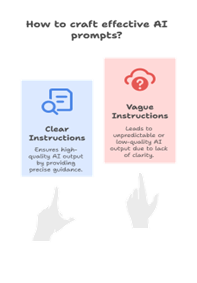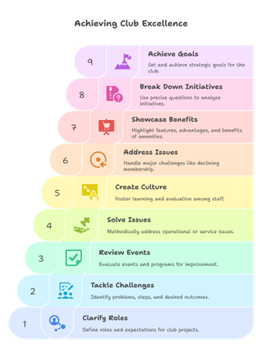
Artificial intelligence is no longer just for tech companies, startups, or universities. It has arrived in industries that are historically built on tradition—private country clubs included. For many managers, that’s both exciting and intimidating.

You’ve probably heard phrases like 'prompt engineering' or 'AI frameworks.' These terms sound technical, but here’s the truth: prompts are simply the way we give instructions to AI. And just like giving instructions to a staff member, the clarity of your request determines the quality of the outcome.
When managers learn how to use prompts well, AI can become a practical tool—one that supports decision-making, improves operations, strengthens member service and increases staff morale. That’s what this 10-part series is all about: showing private club leaders how to use proven prompt frameworks to solve everyday challenges.
Clubs are service-driven organizations. Whether it’s running a dining room, planning events, managing staff schedules, evaluating financials, or introducing a new amenity, success depends on coordination, communication, and clear expectations.
AI can support these efforts in meaningful ways. But it’s not magic. You won’t get useful insights by typing vague requests like 'Help me with membership.' The results will be generic. Instead, structured prompts—built with a framework—help you get targeted, actionable outputs.
For example:
- A vague prompt: 'Give me ideas for a club event.'
- A structured prompt: 'You are an experienced Club Events Manager who actively participates in CMAA and have visited countless other private clubs to see what types of events these clubs host, how they market the events and how the clubs manage them. Use the R-A-C-E framework to design a fall member-guest tournament. Include roles, tasks, context, and success measures.'
The second prompt above produces an outline that’s relevant, detailed, and ready to use.
Khizer Abbas of Superhuman, one of the largest AI media companies in the world, developed 9 ChatGPT Prompt Frameworks To Help Master AI that can be used as a guide in any industry. Over the next nine articles, I’ll walk through the nine frameworks that take the guesswork out of writing prompts for private clubs. Each one acts like a recipe: follow the structure, and you’ll consistently get better outcomes.
Here’s a preview of what’s ahead, adapted for private clubs:
· R-A-C-E – Clarify roles and expectations for club projects.
· R-I-S-E – Tackle challenges by identifying problems, steps, and desired outcomes.
· S-T-A-R – Review events and programs for continuous improvement.
· S-O-A-P – Solve operational or service issues methodically.
· C-L-E-A-R – Create a culture of learning and evaluation among staff.
· P-A-S-T-O-R – Address major issues like declining membership or event attendance.
· F-A-B – Showcase features, advantages, and benefits of club amenities.
· 5-W-1-H – Break down initiatives with precise questions (who, what, when, where, why, how).
· G-R-O-W – Set and achieve strategic goals for the club.

Each article will cover:
- A plain-language explanation of the framework.
- A private club example (like member dining, golf, racquets, aquatics, or events).
- A sample prompt you can try directly with AI.
- Tips on how to interpret and act on the response.
By the end of this series, you’ll be able to:
- Write prompts that produce practical, club-ready outputs.
- Save time on planning, analysis, and communication.
- Spark creative ideas for events, amenities, and services.
- Support your staff by giving them a tool that helps structure their work.
Think of these frameworks as management aids. They won’t replace your judgment, experience, or the “human touch” that defines private clubs. But they will give you a sharper toolset to bring clarity and consistency to your ideas.
Here’s a simple prompt you can try to set the tone for your own use of AI:
"You are the General Manager of a private country club. Write a message to my department heads explaining why we are exploring prompt frameworks to use AI more effectively. Keep the tone professional but approachable. Include three practical examples of how prompts might help in their daily work."
In the next article, we’ll dive into the first framework: R-A-C-E (Role, Action, Context, Expectation). We’ll look at how to use it when planning a new dining concept or member event—making sure everyone knows who is responsible, what needs to happen, the background behind the decision, and what success looks like.
For now, reflect on this question:
If AI could take one repetitive, time-consuming task off your plate, what would it be?
That answer will give you a good starting point as you follow this series.